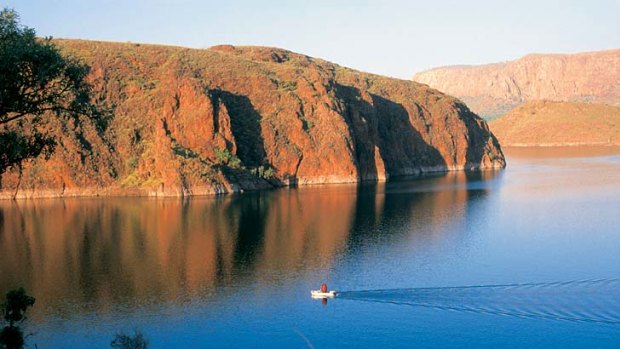This was published 11 years ago
Kimberley ... for the lure of barramundi
By Mal Chenu

Lake Argyle, near Kununurra, Western Australia.
THE locals in the Kimberley are a laconic lot. They're hard-working, no-nonsense types with not a whole lot of respect for mollycoddled city folk. They are generally friendly, relaxed and only wear a suit if they're hoping for a lighter sentence.
It's bad enough if you're from Perth ("that huge, filthy city down south") but if you're from Sydney, you may as well be from Andromeda. Striking up a conversation can be a challenge - topics such as politics, literature or movies can be met with little more than a disinterested grunt.
But bring up barramundi and eyes light up, body language brightens and the discourse flows (albeit generally one way) with great passion. Everyone loves barramundi and everyone knows the best ways to find 'em, play 'em, catch 'em, clean 'em, store 'em, prepare 'em, season 'em, cook 'em, the best beers to down 'em with and the most effective colour, shape and construction of lures to use to hook 'em. Bait is for wimps.
Barramundi, like their pursuers, are a bit different. They are what is called sequentially hermaphroditic, meaning they are mostly male when they are young before becoming female, generally after one spawning season, so most of the bigger specimens are female.
As I sit in the dinghy in the Berkeley River casting and casting and pondering sequential hermaphroditicity, Cam, our guide from Kimberley Quest II, which cruises these waters, scans the river for the telltale surface thrashing that signals the presence of the esteemed barra. Apparently they like to hang around rock faces, mangrove roots or in churned-up water.
Cam tells me to cast near the river bank where the water has changed from muddy to muddier. I hook a tree, which puts up quite a fight and eventually gets away. Cam rolls his eyes.
Cam is a determined fisherman. He has shown me how to cast, what to look for and also what to listen for, as barramundi make a distinctive "whoop" sound when they grab the lure. He is very keen that we all get the chance to catch a barra and keeps us out way past beer o'clock to help us achieve that.
Eventually, after another mis-cast, I hook a trevally, much to my delight but to Cam's annoyance as my prize catch has gulped down the entire lure and Cam has to set me up again. To me, a fish is a fish, but Cam's lack of enthusiasm is palpable. Trevally are second-class fish. We resume our casting and I try not to snag - mostly successfully - my three fellow fishers.
In more populated fishing spots, such as Ivanhoe Crossing near Kununurra, large signs inform that kept barramundi must be 55 centimetres to 80 centimetres long and the bag limit is one fish per fisher. This is fine as most are in it for the sport.
Barramundi are good fighters and as such are prized by sporting fishers. They kick and dive and often breach as the tug of war rages. They are almost always thrown back and quite a few fishers told me how disappointing it is when they catch a good eating specimen too early. They would much rather it took at least five stubbies - as time is measured in these parts - before they landed their dinner.
Sign up for the Traveller Deals newsletter
Get exclusive travel deals delivered straight to your inbox. Sign up now.